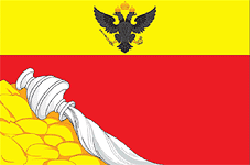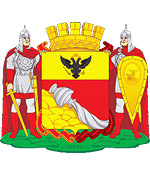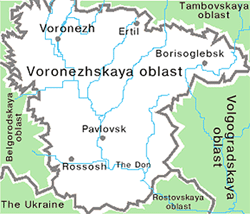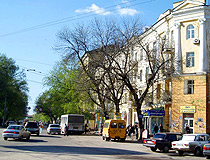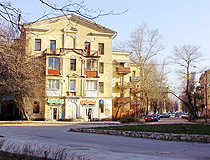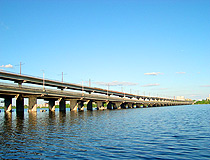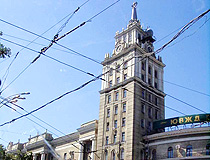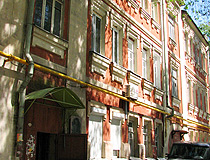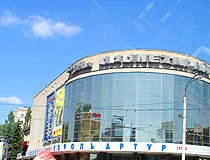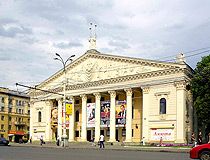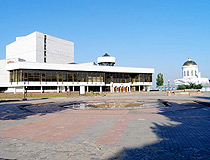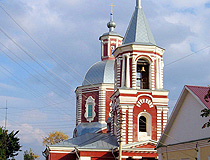History of Voronezh
Foundation of Voronezh
The first mention of Voronezh dates back to 1177 in connection with the battle of the Vladimir and Ryazan princes and the escape of Yaropolk of Ryazan to “Voronozh”. Some historians suggest, based on fragments of these chronicles, that Voronezh (Voronozh) existed as a settlement back in the 12th century. Other historians believe that the chronicle meant only the Voronezh River.
The second, very significant, mention of Voronezh in the chronicles refers to 1237, when the conquest of the Russian principalities by Khan Batu began during the Western campaign of the Mongols. The Russian princes decided to give the first battle to the enemies “and came out against them in Voronozh”, but were defeated. Again, the word “Voronozh” probably means the Voronezh River, not a settlement.
The Tsar’s decree on the foundation of Voronezh has not yet been found. The archive has an order of the boyar Nikita Yuriev from 1586 on the reorganization of the guard service on the southern outskirts of the Moscow state and on the construction of two fortified settlements: Livny and Voronezh. Thus, the official year of the foundation of Voronezh is 1586.
Located on the trade route at the confluence of the Voronezh River with the Don, Voronezh could not remain an exclusively military town for a long time. In 1615, its population was about 7 thousand people. From the middle of the 17th century, Russian and foreign ambassadors to the Ottoman Empire, the Crimean Khanate, and the Caucasus travelled through Voronezh. It became part of the Belgorod line - fortifications that protected the Russian state from the raids of the Crimean Tatars until the end of the 17th century.
More Historical Facts…
Voronezh - the cradle of the Russian navy
In 1695, during the first Azov campaign, Russian troops were unable to capture the fortress of Azov standing on the bank of the Don River, several kilometers from its confluence with the Sea of Azov. The siege was unsuccessful, as the Ottoman garrison in the fortress received support from the sea.
Therefore, Peter I decided to start building a fleet. Voronezh was chosen for this because of its strategic position on the Voronezh River flowing into the Don. Secondly, there were forests near the town that could be used as building materials. Thirdly, the residents of Voronezh had experience in the construction and use of river vessels.
In 1696, as a result of the second campaign, the Azov fortress was taken by Russian troops. The Russian fleet prevented the supply of people, ammunition and food to the fortress. From 1696 to 1711, about 215 ships were built in Voronezh, including the ship “Goto Predestinatsia” (The Providence of God) - the first Russian ship of the line.
In Voronezh, the organizational foundations for the subsequent construction of the Russian fleets in the Baltic and Black Seas were laid. The first Admiralty in Russia was also created here. However, the military shipyard in Voronezh did not exist for long due to the gradual shallowing of the rivers.
Voronezh in the 18th-19th centuries
In 1709, Voronezh became part of the Azov Governorate. In 1711, its center moved from Azov to Tambov, and in 1715 - to Voronezh. In 1725, after the death of the first Russian emperor, the region was renamed into the Voronezh Governorate. In 1745, the first educational institution was opened - the theological seminary (closed in 1918, reopened in 1993).
In 1748, Voronezh was badly damaged by fire. Almost the entire center, which was located on the bank of the river, burned down. After that, the center of Voronezh again began to be located in the place of today’s Universitetskaya Square.
In 1774, after another big fire, Catherine II approved the general plan for the regular development of Voronezh. In the second half of the 18th - the first half of the 19th centuries, Voronezh was one of the centers of the Russian cloth industry.
In 1781, the coat of arms of Voronezh was approved: “The shield is divided in two, in the upper part in a golden field - a two-headed black eagle, and in the lower part in a red field - an overturned jar, from which the Voronezh River flows”.
In 1863, according to the census of residents, Voronezh numbered 38,672 people (the 12th largest city in the Russian Empire). The first public library was opened in 1864. In 1868, Voronezh was connected by railway with Moscow, in 1871 - with Rostov-on-Don, in 1894 - with Kursk.
Voronezh in the first half of the 20th century
In 1913, the first secular higher educational institution in Voronezh was opened - the Agricultural Institute named after Peter the Great (Voronezh State Agrarian University named after Emperor Peter I). In 1914, the population of the city was 93,700 people. During the First World War, reserve military units were formed in Voronezh, defense enterprises from the western regions of the Russian Empire were evacuated here.
In 1928, Voronezh became the center of the Central Black Earth Oblast. And after its liquidation in 1934, it remained the center of Voronezh Oblast. On August 2, 1930, the first Soviet airborne assault was parachuted two kilometers from Voronezh. Today, August 2 is celebrated as the birthday of the Russian airborne forces.
In 1932, two large factories were built on the left bank - aviation and rubber. One of the most important industrial and scientific complexes in the USSR was formed in the city. Many types of aircraft produced in Voronezh began to enter the Red Air Force several years before the outbreak of World War II. In 1939, the population of Voronezh was 326,932 people.
In October-November 1941, during the Second World War, most of the large enterprises were evacuated to the east. From July 7, 1942 to January 25, 1943, the right-bank part of Voronezh, being under German occupation, suffered significant damage, about 18 thousand houses were destroyed (92% of all residential buildings). The active defense of Voronezh helped the Red Army to withstand and win in Stalingrad.
In November 1945, it was decided to prioritize the restoration of 15 oldest Russian cities, including Voronezh. In the late 1940s, the restoration of industrial enterprises was completed, by the mid-1950s - residential and public buildings. In 1956, the population of the city exceeded 400 thousand people.
Voronezh in the second half of the 20th century
In 1968, the first serial Soviet supersonic passenger aircraft Tu-144 was produced at the Voronezh Aviation Plant; in October 1977 - the first Soviet airbus (wide-body aircraft) Il-86. In 1972, the Voronezh reservoir was built, which became the largest in the region.
In 1983, about 6 km from the city limits, the construction of the Voronezh nuclear power plant for heat supply began. In 1990, under the influence of the Chernobyl disaster, it was suspended on the basis of a referendum held among Voronezh residents. The station, which was approximately 65% completed, was mothballed. In 2020, work began on its dismantling. In 1989, the population of Voronezh was about 887,000.
In the 1990s, in connection with the collapse of the USSR, the largest industrial enterprises of Voronezh were on the verge of bankruptcy due to a sharp decline in defense orders and the breakdown of existing economic ties. A lot of churches were returned to the Russian Orthodox Church; their restoration was carried out.
In the early and mid-1990s, agreements on twinning relations were concluded between Voronezh and the cities of Charlotte (USA), Chongqing (China) and Sliven (Bulgaria).
In 2008, Voronezh was awarded the title “City of Military Glory”. In 2009, a new Cathedral of the Annunciation, the third largest Orthodox church in Russia, was built to replace the destroyed one. On December 17, 2012, a millionth resident was born in the city, which made Voronezh the 15th city in Russia with a population of over 1 million.
Street views of Voronezh
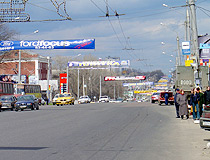
On a busy street in Voronezh
Author: Lantsov Dmitriy
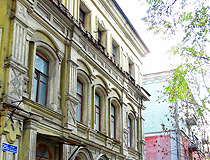
Autumn in Voronezh
Author: Katerina Sorokina
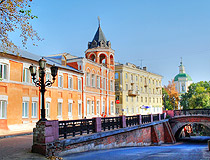
Beautiful architecture of Voronezh
Author: Boris Fedorov
Voronezh - Features
Initially, the city stood on the banks of the Voronezh River. In the 1970s, it was turned into a reservoir - one of the largest reservoirs in the world located entirely within the city. The Voronezh reservoir divides the city into two parts. Its center, cultural institutions, embankments, the best establishments, and the most prestigious districts are located on the right bank. On the left bank there are industrial enterprises, residential areas, and one beautiful park. The two banks are connected by three bridges: the longest of them is Severnyy Bridge (2 km long).
There are several versions of the origin of the name of the Voronezh River after which the city of Voronezh was named. Most likely it comes from the word “voron” (“raven”) or “voronoy” (black) reflecting the dark color of the water in the Voronezh River. The City Day of Voronezh is celebrated annually on the third Saturday of September.
Voronezh is located in a temperate zone. Winter is moderately frosty with a permanent snow cover that forms in December. Quite often there are thaws accompanied by rains (especially in December). Also there are often drops in temperature below minus 20 degrees Celsius, which can last up to a week or more.
Summer is warm, even hot (especially July and the first half of August), in some years - rainy, in some years - dry. Autumn is mild and rainy. The Voronezh reservoir is covered with ice in late November - early December. Spring ice drift lasts from March to April. The average temperature in January is minus 7.6 degrees Celsius, in July - plus 22.7 degrees Celsius.
Voronezh is the economic center of the Voronezh region and one of the largest economic centers in Russia. The leading sectors of the economy are food, chemical, radio-electronic industries, mechanical engineering and retail trade. The largest enterprises of Voronezh are Voronezh Joint-Stock Aircraft Building Company, Voronezh Mechanical Plant, Voronezh Ceramic Plant, Carriage Repair Plant named after V.I. Thalmann.
This city is a major transport hub, the transport system of which consists of air, rail and road transport systems. The Peter the Great Voronezh International Airport offers regular flights to Moscow, St. Petersburg, Sochi, Kaliningrad, Samara, Krasnodar, Novosibirsk, Kazan, Yekaterinburg, Rostov-on-Don. Public transport is represented by mini-buses, buses and trolleybuses.
Voronezh is worth visiting not only for its interesting museums, beautiful parks and picturesque squares. Here you can also see funny monuments to animals - heroes of famous literary works, replicas of the first ships of the Russian navy, unusual buildings in the Art Nouveau and Gothic style of the late 19th-20th centuries.
There are a lot of traditional Russian churches, theaters, and former merchant mansions in Voronezh that catch the eye with their noble and elegant appearance. Also, tourists should pay attention to the monuments perpetuating the image of the heroes of the Second World War. The Voronezh Sea, a huge reservoir stretching for tens of kilometers, is of no less interest.
Main Attractions of Voronezh
Monument to White Bim Black Ear - one of the unofficial symbols of Voronezh; a dog sitting on a pavement and patiently waiting for the return of its owner. The monument is dedicated to the main character of the story of the same name created by the Voronezh writer Gavriil Troyepolsky. The monument is located at Revolyutsii Avenue, 48, near the puppet theater “Shut” (“Jester”).
Monument to Kitten from Lizyukova Street - a monument dedicated to the kitten Vasily from the Soviet cartoon “Kitten from Lizyukova Street”, who, according to the plot, lived on Lizyukova Street in Voronezh. The monument looks like a tree on the branches of which a kitten and a crow are sitting and conducting a conversation. Generala Lizyukova Street, 4.
Memorial Complex “Victory Square” - one of the central squares of Voronezh with the memorial complex in honor of the defenders of the city in 1942-1943. At the northern end of the square, there is a monument made of red granite and metal, consisting of 12 figures depicting all branches of the Red Army, as well as partisans and militias. The eternal flame burns in front of the monument. At the southern end of the square, there is a 40-meter high stele.
Annunciation Cathedral (1998-2009) - the third largest Orthodox church in Russia and one of the tallest Orthodox churches in the world (85 meters) constructed in a picturesque Russian-Byzantine style and located in close proximity to Victory Square. Revolyutsii Avenue, 14B.
Cathedral of the Intercession of the Most Holy Theotokos (1833-1841) - one of the main architectural sights of Voronezh. The main feature of this church is its gradual construction, in several stages, therefore its premises differ stylistically. Bekhtereva Street, 36.
Voronezh Museum of Local Lore - one of the leading museums in Voronezh. Here you can see numismatic, ethnographic, philatelic, weapons collections, as well as collections of porcelain, ceramics, rare books, and other unique exhibits. The main building of the museum is a picturesque urban mansion of the early 20th century with a bright red facade. Plekhanovskaya Street, 29. The museum “Arsenal”, a department of the local history museum, is completely devoted to weapons of the 13th-20th centuries and the Second World War. Stepan Razin Street, 43.
Ship Museum “Goto Predestinatsia” - a replica of a real ship from the times of Peter I docked at Admiralty Square; the first Russian ship of the line. Its exposition tells about the origin and development of the Russian navy. Another attraction located on Admiralty Square is the Assumption Admiralty Church built in the 17th century - the oldest preserved church in Voronezh.
Art Museum named after I. N. Kramskoy - one of the largest cultural centers of Voronezh located in a palace built in the Baroque style in 1777-1779, an architectural monument of federal significance. The museum presents a unique collection of art works of Ancient Egypt, antiquity, Russian and Western European painting of the 18th-20th centuries, icon painting, graphics, decorative and applied art, sculpture, paintings created by famous Voronezh artists, as well as works of contemporary Voronezh artists. Revolyutsii Avenue, 18.
“Museum of Forgotten Music” - one of the most interesting and unusual exhibitions in Voronezh, which consists of musical instruments of different nations. The collection includes exhibits found in different parts of Russia, many of which have been restored. Another part of the unusual exposition is the instruments that have been recreated from books, old drawings, and even from works of art. It is noteworthy that any of the exhibits can not only be touched and held in hands, but you can also play them. 9 Yanvarya Street, 108.
Rotunda - the ruins of the main entrance to the building of the Voronezh regional children’s hospital. Destroyed during the battles for Voronezh during World War II, it was preserved as a monument that always reminds of what hard times the city left behind. There are similar monuments in Berlin and Dresden (Germany), in Coventry (England), in Warsaw (Poland), and in Volgograd (former Stalingrad). Transportnaya Street, 69.
Park “Scarlet Sails” - one of the most beautiful natural attractions of Voronezh, located in the Levoberezhny (left-bank) district of the city, on the bank of the Voronezh reservoir. The total area of this pine park is 6.2 hectares. For residents and guests of the city, various concerts and festive programs, fairs, and theatrical performances are held here. Arzamasskaya Street, 4?.
Voronezh Oceanarium - one of the best oceanariums in Russia located in the village of Solnechny (Parkovaya Street, 3), about 3 km from the city limits of Voronezh along the Voronezh-Moscow highway. This oceanarium features 180 species of fish, 55 species of mammals, birds, reptiles, invertebrates, and other animals.
Princess Oldenburg’s Palace (Ramon Palace) - a unique palace complex of the late 19th century located in the village of Ramon, about 37 km north of Voronezh, a brick neo-Gothic architectural monument rare for the Russian province. Its owner was the granddaughter of Emperor Nicholas I and the niece of Emperor Alexander II, Princess Eugenia Maximilianovna of Oldenburg.
Natural, Architectural, and Archaeological Museum Reserve “Divnogorye” - one of the most popular and recognizable attractions of the Voronezh region, located on the right bank of the Don River, about 80 km south of Voronezh. Divnogorye is the center of Orthodox pilgrimage. Here you can see archeological monuments of the Paleolithic, Bronze, and Middle Ages. The unique Church of the Sicilian Icon of the Mother of God, built by Russian monks inside a chalk mountain in the first half of the 19th century, is its main sight.


